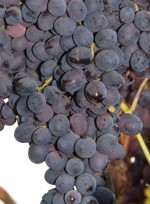
Black Monukka Seedless Grape - Bareroot Season
Large, purplish-black, sweet, crisp. Does not require as much summer heat as Thompson. Fresh or raisins. Early mid-season. 100 hours. Self-fruitful.
Flame Seedless Grape - Bareroot and in containers
Medium-sized, light red. Crisp, sweet, excellent flavor. For fresh use or raisins. Needs hot summer. Ripens early, before Thompson. Vigorous. 100 hours. Self-fruitful.
Muscat of Alexandria Grape-Bareroot season primarily. Ocassionally available in containers.
Large, dull green, egg-shaped. Juicy, distinctive flavor and aroma. Table, wine, raisins. Not suited to hot desert climates. 100 hours. Self-fruitful.
Perlette Seedless Grape - Bareroot season
Pale green berry is crisp and juicy. Larger than Thomspon and two weeks earlier. Requires less summer heat than Thompson to ripen. 100 hours. Self-fruitful.
Ruby Seedless Grape- Bareroot and in containers
Dark red, sweet, crisp, excellent fresh or for raisins. Ripens after Thompson Seedless. Requires less summer heat than Thompson or Flame. 100 hours. Self-fruitful.
Thompson Seedless Grape- Bareroot and in containers
Most popular grape in California, Arizona. Fresh and raisins. Pale green, very sweet. Thin the clusters for larger berries. Needs plenty of heat. 100 hours. Self-fruitful.
Concord Grape(Eastern Concord)- Bareroot and in containers
Versatile, long-time favorite American grape. Blue-black berry with rich, distinctive flavor, used for table, juice, jelly and wine. 100 hours. Self-fruitful.
Concord Seedless Grape - Sometimes available in bareroot and ocassionally available in containers
American grape, a sport of Concord. Berries very similar to Concord, but seedless(or seeds very rare). Bluish-black skin, green flesh, distinctive Concord flavor. 100 hours. Self-fruitful.
Niagara Grape- Bareroot season
Medium to large, green to pale yellow-green berries with 1-6 seeds. Juicy, sweet, tart at center, slightly foxy flavor. Used for table, juice, wine. Moderately vigorous vine hardy to 0 degrees F. Originated as chance seedling of Concord. 100 hours. Self-fruitful.